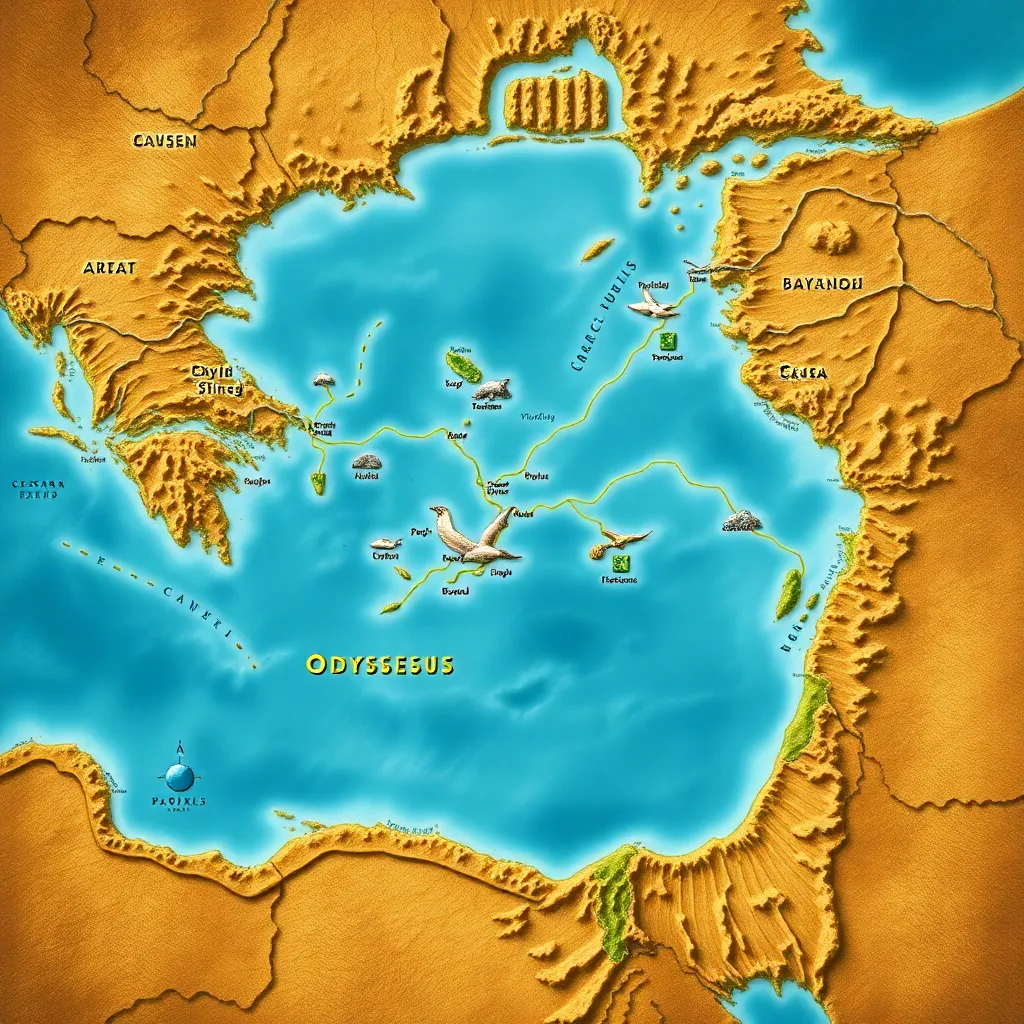The Geography of Odysseus’s Journey: Mapping the Odyssey
I. Introduction
Homer’s “The Odyssey,” an epic poem composed in ancient Greece, narrates the adventurous journey of Odysseus as he attempts to return home to Ithaca after the Trojan War. This narrative is not only a tale of heroism and cunning but also a reflection of the geographical landscape of the time, rich with mythical places and divine interventions. The geographical aspects of Odysseus’s journey play a crucial role in shaping the story and the lessons it imparts.
This article aims to explore the geography of Odysseus’s journey, highlighting key locations, the influence of gods, and the cultural significance of the landscape he traverses. By mapping these elements, we gain a deeper understanding of the epic and its relevance both then and now.
II. The Mythical Landscape of the Odyssey
The ancient Greek worldview was deeply intertwined with nature and mythology. The landscape was not merely a backdrop for human actions; it was filled with divine significance and supernatural elements. Mountains, seas, and islands were perceived as the domains of gods and mythical creatures, creating a rich tapestry of adventure and danger.
In “The Odyssey,” the blend of myth and reality creates a unique geographical framework. While some locations are based on real places known to the Greeks, others are entirely mythical, reflecting the beliefs and imaginations of the time. This duality enhances the narrative, making the journey both relatable and fantastical.
III. Key Locations in Odysseus’s Journey
Odysseus’s journey encompasses several significant locations that shape his experiences and challenges. Below are some of the key locations featured in the epic:
- Ithaca: The Homecoming
- Troy: The Starting Point of the Adventure
- The Land of the Cyclopes: A Dangerous Encounter
- Aeolia: The Island of the Wind God
- The Underworld: A Journey Beyond the Living
A. Ithaca: The Homecoming
Ithaca is the ultimate destination of Odysseus’s journey. It symbolizes home, family, and identity. The struggles and trials faced by Odysseus throughout the epic are ultimately aimed at reclaiming his rightful place in Ithaca.
B. Troy: The Starting Point of the Adventure
The narrative begins at Troy, where Odysseus fought in the Trojan War. This location marks the transition from war to the arduous journey of returning home, setting the stage for the trials that follow.
C. The Land of the Cyclopes
One of the most famous episodes in the Odyssey takes place in the land of the Cyclopes, where Odysseus and his men encounter the giant Polyphemus. This location highlights the theme of cunning versus brute strength, as Odysseus must rely on his wits to escape.
D. Aeolia: The Island of the Wind God
Aeolia, home to the wind god Aeolus, plays a pivotal role in Odysseus’s journey. Aeolus gifts Odysseus a bag of winds to help him sail home, but a lack of trust among his crew leads to their downfall, emphasizing the fragility of fortune.
E. The Underworld: A Journey Beyond the Living
Odysseus’s descent into the Underworld is a critical moment that provides insight into his character and the fate of heroes. This journey underscores the connection between the living and the dead, revealing the importance of knowledge and prophecy.
IV. The Role of the Gods and Divine Intervention
The gods play a significant role in shaping Odysseus’s journey, often intervening at crucial moments. Key deities include:
- Athena: The goddess of wisdom and warfare, who aids Odysseus throughout his trials.
- Poseidon: God of the sea, who becomes Odysseus’s antagonist after he blinds Polyphemus.
- Circe: A sorceress who initially detains Odysseus but later provides him with guidance.
The locations tied to these divine actions illustrate the interplay between fate and free will in the epic. Odysseus’s journey is not solely a physical one, but also a spiritual quest influenced by the whims of powerful deities.
V. Mapping the Journey: Routes and Distances
Scholars have long debated the geographical accuracy of Odysseus’s journey. Analyzing textual references allows for a reconstruction of his route, which might look something like this:
- Troy
- Aeolia
- Land of the Cyclopes
- Circe’s Island
- The Underworld
- Return to Ithaca
Modern maps and interpretations have emerged, attempting to align Homeric locations with real-world geography. However, the blending of myth and reality complicates these efforts, leading to various theories about the actual locations of Odysseus’s adventures.
VI. Cultural and Historical Significance of the Journey
The geography of Odysseus’s journey reflects the cultural and historical context of ancient Greece. Key themes include:
- Exploration and Adventure: The journey symbolizes the human quest for knowledge and experience.
- Identity and Belonging: Ithaca represents the importance of home and the struggle for identity.
- Morality and Ethics: Encounters with various cultures prompt reflections on morality and human nature.
These themes resonate deeply within ancient Greek culture, influencing literature, philosophy, and the arts.
VII. Modern Interpretations and Adaptations
The enduring legacy of “The Odyssey” is evident in contemporary literature and media. Modern adaptations often explore geographic themes, emphasizing the journey’s significance in a globalized world:
- Books and novels that reimagine the story from different perspectives.
- Films and television series that adapt the narrative for modern audiences.
- Artistic representations that visualize the epic’s mythical landscapes.
The geographic themes in these adaptations continue to inspire audiences, inviting new interpretations of Odysseus’s journey.
VIII. Conclusion
In summary, the geography of Odysseus’s journey in “The Odyssey” serves as a powerful framework for understanding the epic’s themes and characters. From the mythical landscapes to the divine interventions, each location plays a vital role in shaping the narrative. The exploration of these geographical elements offers insights into ancient Greek culture and the human experience.
Odysseus’s journey remains a timeless reflection on the quest for identity, belonging, and the impact of our environment on our lives. As we continue to explore the themes and locations of this epic, we invite further inquiry and appreciation of its profound legacy.




